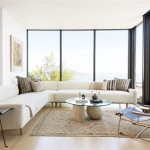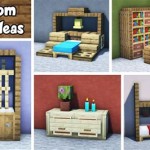How to Decorate a Room With Slanted Walls
Rooms with slanted walls, often found in attics or basement spaces, present unique design challenges. While the sloping ceilings can create a cozy, intimate atmosphere, they can also make it difficult to arrange furniture and maximize space. However, with a strategic approach to decorating, you can transform these challenging spaces into beautiful and functional areas. This article explores effective techniques for decorating rooms with slanted walls, offering tips to maximize their potential and create a harmonious and aesthetically pleasing environment.
Embrace the Unique Character of Slanted Walls
The first step in decorating a room with slanted walls is to embrace the unique character they bring. Instead of trying to disguise the slopes, highlight them with clever design choices. Consider using paint colors that complement the angles, like warm neutrals or bold accents that draw the eyes upward. For example, painting the sloped walls a lighter shade than the main walls can create a sense of spaciousness and draw attention to the unique ceiling shape.
You can also use the slant to create visual interest by incorporating architectural elements like built-in bookshelves, window seats, or even a small reading nook. These features can be seamlessly integrated into the sloping space, utilizing the available area effectively. Remember, the key is to find a balance between embracing the angle and making the room feel cohesive and functional.
Maximize Space with Smart Furniture Placement
One of the biggest challenges of designing with slanted walls is optimizing the limited floor space. To maximize your room's potential, think vertically and strategically place your furniture. Low-profile seating, such as ottomans or benches, can be placed under the slopes, leaving the taller pieces to stand against the straight walls.
For rooms with multiple slanted walls, consider choosing furniture with different heights and shapes to create visual interest and accommodate the unique angles. For instance, a shorter sofa can be paired with a taller armchair placed near the angled wall, providing a balanced and visually pleasing arrangement.
When choosing furniture, consider its height and depth. A low-profile sofa or bed will allow for more usable space underneath the slope, while a deep armchair might be better placed against a straight wall. Before committing to a specific piece, it's helpful to create a floor plan and experiment with different furniture arrangements to find the most efficient and visually appealing solution.
Utilize Light and Color for Space Illusion
The strategic use of light and color can significantly alter the perception of a room with slanted walls. Light, airy colors create a sense of spaciousness and openness, ideal for smaller spaces with limited natural light. Conversely, darker shades can make a room feel smaller and cozier.
Consider using light colors on the slanted walls and a darker shade on the main walls to create a sense of depth and visual interest. For example, using a pale green on the slopes and a deep green on the main walls will visually expand the space and create a layered effect.
Natural light plays a crucial role in maximizing the sense of space. If your room has windows, ensure they remain unobstructed and consider using mirrors to reflect existing light. If natural light is minimal, strategically placed lamps and overhead lighting can create a bright and inviting atmosphere.
Incorporate Unique Storage Solutions
Slanted walls can present storage challenges, but with creative solutions, you can maximize your space and keep your belongings organized. Consider incorporating built-in shelves or cabinets that seamlessly integrate into the slanted wall design. This not only provides functional storage solutions but also adds a touch of architectural interest to the room.
If you prefer a less permanent option, floating shelves, wall-mounted organizers, and storage baskets can be strategically placed on the slanted walls, making use of the otherwise unused vertical space.
When designing your storage solutions, consider the available height and depth of the slopes. For example, narrow shelves would be more suitable for storing smaller items like books or decorative objects, while deeper shelves could accommodate larger items like boxes or baskets.

How To Decorate A Slanted Wall Bedroom

How To Decorate A Bedroom With Slanted Walls Endurance Beds

How To Decorate Rooms With Slanted Ceilings Or Walls

How To Decorate A Slanted Wall Bedroom

10 Savvy Design Ideas That Help Make The Most Of Slanted Ceilings Rooms With Walls Apartment Color Schemes

Decorating With Slanted Ceilings At Home Ashley

How To Decorate Rooms With Slanted Ceilings Or Walls

Apartment Therapy Slanted Wall Bedroom Walls

How To Decorate Rooms With Slanted Ceilings Or Walls

How To Decorate Slanted Walls Vinci Home Services
Related Posts







